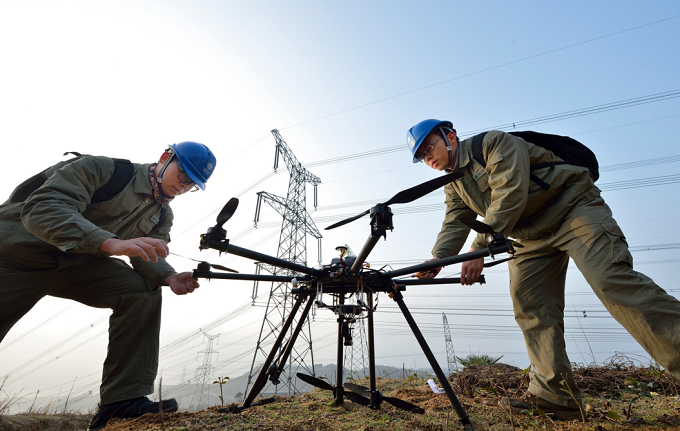
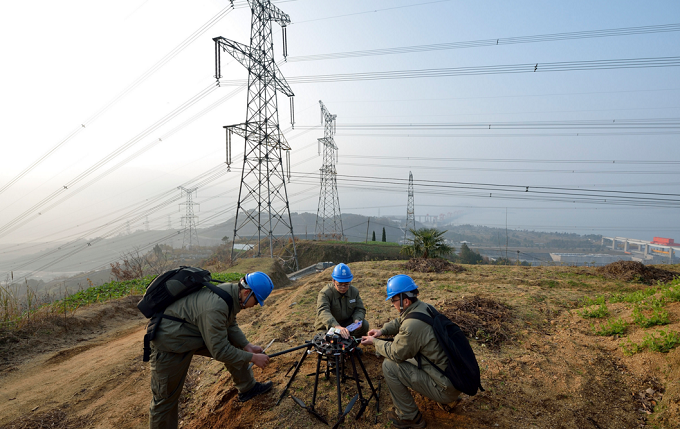
A UAV is inspecting the electric power grids
Qi Juntong, Professor of the School of Electrical and Information Engineering at Tianjin University, has led his team to build intelligent “brains” and “arms” for UAVs (Unmanned Ariel Vehicles) for the past ten years. Intelligent UVAs not only play a significant role in agricultural plant protection, logistics, and electrical power inspection, but also lead the related industries of China taking the leading position in the world.
In the recent agricultural work period, the UAV with high reliability and a stabilized flight control system independently researched and developed by Tianjin University provided an umbrella for crops across China from the Heilongjiang Province in the North to Hainan Province in the South, spraying over 900 tons of agricultural chemicals for more than 65,000 hectares of crops.
Compared to the relatively mature UAV industry in America, the UAV in China is classified into two categories: consumer-grade and commercial-grade. Consumer-grade UAV are widely applied to aerial photography and performance. Commercial-grade UAV are required by virtue of artificial intelligence control system and are applied in various industries to help people.
“In comparison to the consumer-grade UAV flying amid the birds, clouds and beautiful scenery, the commercial-grade UAV usually works in areas filled with crops and densely-covered with high-voltage power lines. Whether the circumstances are appropriate or not, it has to accomplish its mission.” Qi Juntong said.
In general, commercial applications are usually used in designated environments like electric transmission line inspections, or express delivery logistics. No matter if obstructed by different kinds of buildings or faced with various kinds of crossings, the intelligent UAV has to finish its mission, which means not only does it need an “cerebellum” but also to use its “brain”. Like humans, its “cerebellum” is responsible for balance and stability, and the “brain” is in charge of estimating the environmental perception and judging abilities. The unique adaptive data fusion algorithm independently developed by Qi Juntong’s team has been applied to various UAV flight control systems, for it is the integration of multi-sensor data perceived by complicated environments, multi-redundant, highly stable flight control system and advanced control algorithm, which is equivalent of equipping the UAV with a “brain”. “We should make sure that the UAV is capable of observing and estimating the complicated surroundings so as to find the way home, to closely interact with environment, and to be equipped with learning and data analysis abilities.” Qi Juntong expounded.
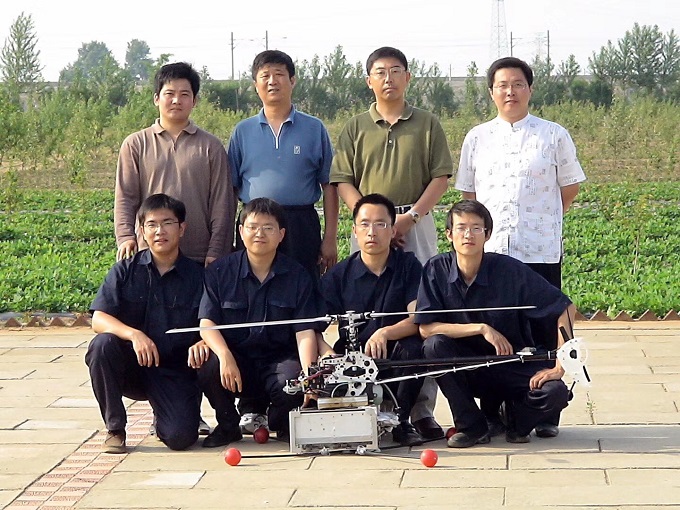
Qi Juntong’s Team and Qi Juntong (first on the left in the first line)
In the field of agricultural plant protection, the spraying insecticides flight control system developed by Qi Juntong’s team not only reaches the industrial grade in temperature, humidity, preservation, waterproofing, but also adapts to the adverse environments of the field. “Using the UAV to spray insecticides is not harmful to crops. It is easier for the UAV to spray insecticides to the back of the leaves, for they are turned by the wind. Meanwhile, the addition of semi-automatic equal width spraying, automatic spraying and other features adapt to the agricultural work. And it largely reduces the complexity for operators using the UAV.” Qi Juntong said.
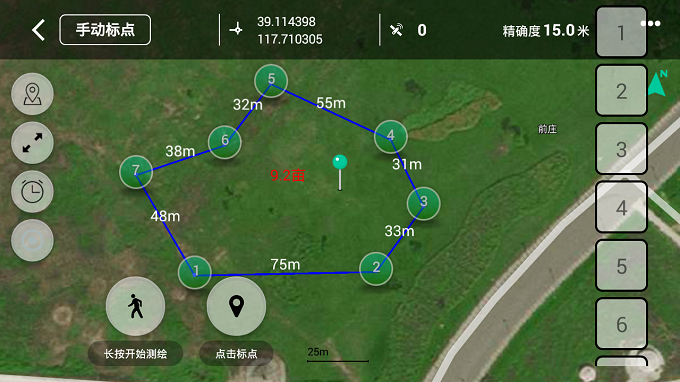
“BAS Farm” platform APP
Including the “brain”, intelligent UAV also has invisible “arms”. Qi Juntong’s team integrates IoT (Internet of Things) cloud computing technology and automatic control technology, and developed “BAS Cloud” platform, the largest scale of aerial unmanned operation total solution nationwide. The platform is not only able to provide large data services for manufacturers and the teams using the plant protection UAV that sprays insecticides to crops, but also provide relevant supervision departments with references. During the 2017 agricultural work period from April to August, the platform received over 80,000,000 valid data inputs, including the areas of operation, the times of operation, the time of air-spraying control, the amount of insecticides, and the amount of money in air-spraying control.
The intelligent UAV can also replace people for inspection work over long distances and in complex environments, such as transmission line inspections, oil pipeline inspections, mobile communication tower inspections, and photovoltaic inspections.
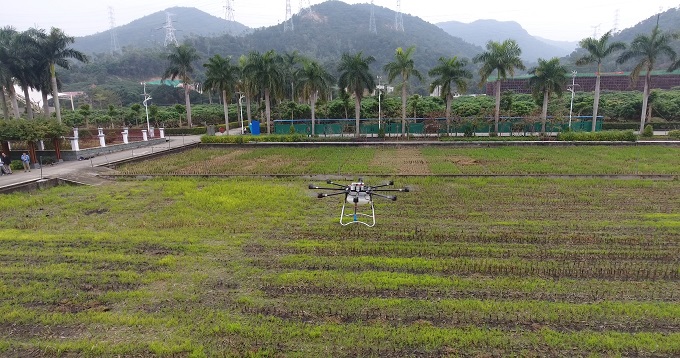
A UAV is spraying insecticides
Traditional manual inspections require people to use a telescope to check the line. On the one hand, the labor costs are high, while the efficiency is low and the inspection results are not always guaranteed. On the other hand, with the use of intelligent UAVs, the inspection efficiency is about 6 times to 10 times of that in the manual operation. The traditional manual inspection needs 5 to 8 hours to remove the unexpected floating objects on the wires and needs to cut the power, while the UAV can work with live power, and quickly remove the floating objects in 15 to 20 minutes. If the UAV is equipped with an infrared thermometer, the work efficiency is increased by 4 times, for it just needs about 10 minutes to complete the former 40 minutes on-tower-operation. "It also has higher requirements for stability and reliability, as well as the operation mode and the process of the UAV system." Qi Juntong said. At present, the intelligent UAV developed by the team has been carrying out electric power inspections in remote areas of southern China.
In recent years, Qi Juntong’s team has been primarily focused on the unmanned transformation of the manned helicopter. The basic idea of unmanned transformation is to continue to use the engine, rotors, transmissions and other main structures of the manned helicopter. Through the structures and electric transformation and the addition of flight control system, the UAV can assist or replace people in forest fire prevention, inspection, logistics transportation, disaster relief and so on. Qi Juntong’s team took the lead in mastering internationally-advanced core technologies. And the team has achieved the transformation of helicopters ranging from 100 kilograms to 3 tons. Depending on independent research and development, Qi Juntong’s team was cited as one of the ten most influential flying robotic research and application teams by the Journal of Field Robotics, which symbolizes Chinese UAV technology beginning to take the internationally advanced level.
Qi Juntong and his colleagues went to Lushan county, Ya’an, Sichuan Province with intelligent UAVs and relevant equipment when a Ms.7.0 earthquake occurred. They used the UAV to check the situation of the region, after gathering with members of the National Earthquake Response Support Service. When they finished collecting data, the rescuers began to conduct search and rescue operations according to the relevant data. “It was the most unforgettable three days in my UAV life. Nowadays, our lives and working environments are being gradually changed by artificial intelligence. We benefit from this change, and we are happy to devote ourselves to it. Liberating people from complicated environments is also our desire.” Qi Juntong said.
By: Peng Shiyue, Sun Xiaofang
Editors: Yin Shiyu, Qi Juntong and Ross Colquhoun






